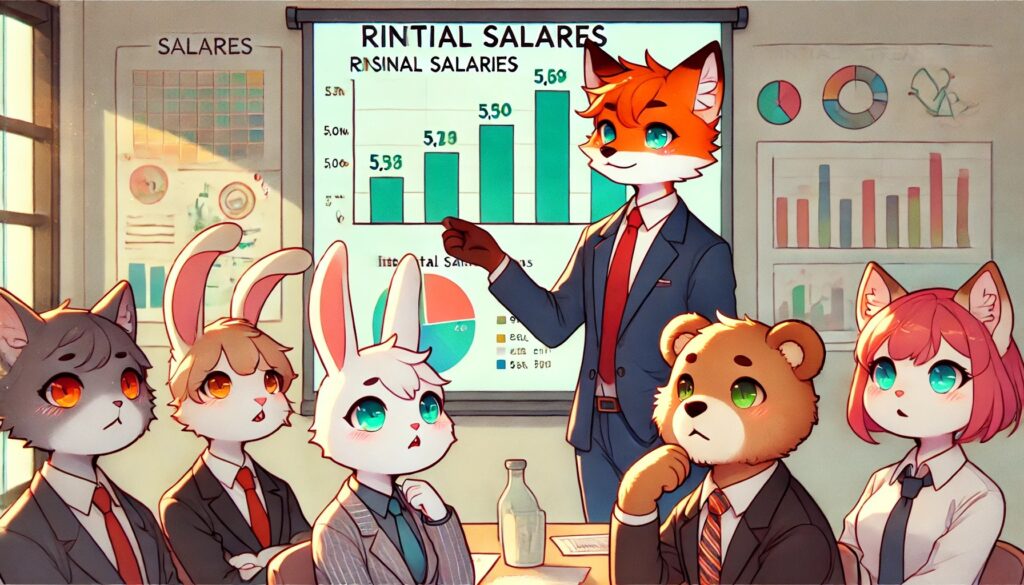Is it true that starting salaries are at a record high? Carefully review job postings and employment contracts. Will lifetime earnings increase? Can wages keep up with inflation? Beware of deceptive wage increases!
Initial Salary at a Record High!
In recent years, Japanese companies have been significantly increasing their starting salaries. According to a 2025 survey by Teikoku Databank, 71.0% of companies plan to raise the starting salaries for new graduates in April 2025, with an average increase of 9,114 yen.
Wage Disparity
Driven by the weak yen, export-oriented industries, particularly large corporations, have seen improved business performance and have consequently raised their starting salaries. However, for small and medium-sized enterprises (SMEs), wage increases remain difficult without an increase in contract amounts, and subcontractors continue to face challenging conditions.
Are Lifetime Earnings Increasing?
While starting salaries have indeed risen, it is crucial to determine whether this increase translates into long-term income growth. Some companies manipulate their wage structures by keeping base salaries stagnant while increasing allowances, making wages appear higher than they actually are.
Will Wages Keep Rising Next Year?
If base salaries remain unchanged, reductions in bonuses and retirement benefits could prevent long-term wage growth. Furthermore, declining salary increment rates and ambiguous evaluation systems may lead to stagnant wages despite initially high starting salaries.
Harsh Conditions for Subcontractors
Even when large corporations raise wages, the benefits do not necessarily extend to subcontractors. With pricing pressure from prime contractors and rising raw material costs, SMEs’ profit margins remain compressed. Thus, wage increases alone are insufficient, and strategic improvements such as operational efficiency and new business development are necessary.
Government Support
To encourage wage increases, the government has introduced support measures such as the “Wage Increase Promotion Tax System” and “Career Development Subsidies” to reduce corporate burdens. However, as only a limited number of companies can take advantage of these benefits, these measures have not yet led to substantial improvement.
Large Corporations Must Circulate Profits
To address these issues, large corporations must set appropriate contract prices, ensuring that SMEs receive a fair share of profits. Additionally, the government should enhance transparency in pricing negotiations and strengthen monitoring systems to prevent undue cost-cutting pressures. Supporting SMEs, which form the backbone of Japan’s industry, will require proactive efforts from both large corporations and policymakers.
Has the Starting Salary Really Increased? Latest Data and Corporate Realities
Recent reports indicate a significant increase in starting salaries at Japanese companies. For instance, a survey by Teikoku Databank published on February 14, 2025, revealed that 71.0% of companies plan to increase starting salaries for new graduates in April 2025. The average salary increase is 9,114 yen, driven by factors such as inflation and workforce retention efforts.
Large Corporations Making Substantial Increases
A 2025 survey found that many companies have raised their starting salaries. The most common salary range is “200,000–250,000 yen,” comprising 62.1% of companies, marking a 4.7 percentage point increase from the previous year. Additionally, “250,000–300,000 yen” salaries have increased into double digits, reflecting the trend of rising wages. This increase is particularly evident among large corporations.
Some major corporations have benefited from the weak yen, which has enhanced their export competitiveness and boosted sales. Manufacturing and automotive industries, in particular, have seen increased revenue in yen terms, allowing them to accumulate internal reserves and create room for salary increases. However, businesses dependent on the domestic market and SMEs are struggling due to rising raw material costs, which continue to squeeze profit margins and make wage increases difficult.
Significant Increases in Large Corporations
Many large corporations have reported significant salary increases compared to the previous year. For example:
- Sharp: 251,000 yen (9,500 yen increase from the previous year)
- Toshiba: 250,000 yen (7.8% increase from the previous year)
- Nippon Steel: 265,000 yen (41,000 yen increase from the previous year)
- Suzuki: 251,000 yen (14.1% increase from the previous year)
This trend highlights the growing wage gap between large corporations and SMEs.
Can SMEs Afford Wage Increases?
When examining wage increase rates by company size, SMEs report a higher wage increase rate (71.4%) than large corporations (69.6%). However, small businesses lag behind at 62.2%, revealing a disparity in wage increases based on company size. SMEs face a reality where wage increases are nearly impossible without increased contract amounts from prime contractors.
Harsh Realities for Subcontractors
Subcontractors often experience significant pricing pressure from prime contractors, limiting their ability to pass rising labor costs onto prices. This results in constrained profit margins, making it difficult to allocate resources for wage increases. In such conditions, SMEs must implement not only wage increases but also operational efficiency improvements and business diversification strategies to ensure profitability.
Government Incentives for Wage Increases
To support wage increases, the government offers various tax incentives and subsidies, such as the “Wage Increase Promotion Tax System.” This initiative allows companies that raise employee wages to deduct a portion of the wage increase amount from their corporate tax or income tax. Additionally, the “Career Development Subsidy” provides financial assistance for businesses that improve wages for non-regular employees. However, given that not all companies qualify for these benefits, these policies have yet to achieve widespread impact.
The Illusion of Wage Increases
While many companies appear to be raising salaries, closer inspection reveals that some are doing so through misleading methods, such as increasing allowances rather than base pay. Since base pay determines bonuses and retirement benefits, an unchanged base salary means long-term earnings remain stagnant.
Some companies also lower the annual salary increment rate, making the initial wage increase less impactful over time. Others incorporate overtime pay into fixed salaries, effectively reducing hourly wages for employees who do not work excessive overtime.
The Future of Japan’s Workforce
As Japan shifts from a seniority-based wage system to a merit-based one, there is a risk that evaluation systems may be manipulated to justify lower wages rather than reward employees fairly. This could lead to greater wage instability and potential exploitation of workers.
Thus, job seekers must thoroughly examine job postings to ensure they understand the structure of their salaries, including the breakdown of base pay and allowances. It is also crucial to review salary increase trends, bonus payments, and retirement benefits before making career decisions.
Conclusion: What Job Seekers Should Watch For
While starting salaries are increasing, job seekers should carefully scrutinize whether these increases translate into long-term financial stability. Some companies use deceptive wage structures that may result in stagnant lifetime earnings. Understanding the full salary structure, including base salary, allowances, bonuses, and wage growth potential, is essential for making informed career choices.
The key takeaway is that a high starting salary does not necessarily equate to good long-term compensation. Job seekers should evaluate the overall compensation package, including career growth opportunities and working conditions, before making employment decisions.
The Foundation of Japanese Manufacturing
It is not easy for subcontracting SMEs to implement wage increases under these circumstances. However, many SMEs are making efforts to secure talent through various strategies. These include introducing flexible working arrangements, promoting remote work, and implementing unique skill development programs to make their workplaces more attractive beyond just salary considerations. Additionally, unlike large corporations, SMEs often emphasize greater individual autonomy for employees, highlighting opportunities for personal growth and career advancement. Even in a challenging environment, SMEs are refining their recruitment strategies to attract top talent.
However, a fundamental solution requires large corporations to ensure that sufficient profits trickle down to their subcontractors. By setting fair contract prices and appropriately reflecting cost increases, SMEs can gain the financial capacity to implement wage hikes. Simultaneously, the government must strengthen oversight mechanisms to enhance transparency in price negotiations and prevent unfair cost-cutting pressures. Protecting SMEs, which form the backbone of Japan’s industry, is becoming an increasingly crucial responsibility for both large corporations and policymakers.










